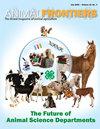Performance-enhancing technologies in swine production
IF 3.2
2区 农林科学
Q1 AGRICULTURE, DAIRY & ANIMAL SCIENCE
引用次数: 20
Abstract
Technology adoption has allowed for dramatic improvements in sow productivity, wean-to-finish growth performance, and carcass composition over the last 35 yr. In 1980, the average sow farm in the US marketed 9.2 pigs per sow per year (Table 1). The average market weight was 242 lb with pigs having more than 1 inch of fat at the 10th rib, a loin eye under 5 in2, and a carcass that produced less than 80 lb of lean meats (National Pork Board, 2016). Growth performance records from 1980 are scarce; however, in 1990, pigs grew at 1.27 lb/day and required 3.2 lb of feed per pound of gain from weaning to market (PigChamp, 1990). By comparison, today’s average sow weans 22 pigs per year and its pigs have a wean-to-finish average daily gain of 1.61 lb/day and use 2.6 lb of feed per pound of gain (National Pork Board, 2016). The average market weight is now 283 lb with 0.72 inches of back fat and a loin eye over 8 in2 (National Pork Board, 2016). Thus, the actual feed required per pig has decreased by 4% while market weight has increased by 17% (41 lb) in the last 25 yr. Of the 41-lb increase in live weight, 38 lb (93% of the increase) has been added to the amount of lean muscle provided by each carcass, with today’s pigs producing more than 118 lb of lean meat per animal. This has allowed for a 38% increase in pork production with only a 10% increase in the annual number of animals harvested over the same time period (USDA-NASS, 2015). These values obviously represent significant improvement in swine productivity. Combining increases in sow productivity and market weight, the average US pig farms are producing more than 4,000 lb of live weight per sow per year compared with approximately 1,770 lb in 1980 (Figure 1). Without these improvements in productivity, it would take another 9 million sows (approximately 15 million in total) compared with today’s 6 million sows to achieve the current level of pork produced (Patience, 2015; Figure 2). With global food demands expected to increase by 100% in 2050, technology must continue to be applied to commercial swine production (Tilman et al., 2011). As demonstrated by the swine industry’s record of rapid adoption and embracing new technology, production of safe, wholesome, and nutritious pork will continue to improve and increase while, at the same time, using fewer resources and reducing its impact on the environment. Therefore, our objective is to review the history of technology development and its application in shaping today’s swine industry (Table 2).猪生产性能提高技术
技术采用允许戏剧性改善母猪生产力,wean-to-finish生长性能,和尸体成分在过去35年。1980年,母猪农场在美国市场每年9.2猪母猪(表1),市场的平均体重是242磅猪有超过1英寸的脂肪10肋,腰5 in2下眼睛,和尸体产生少于80磅的瘦肉(国家猪肉委员会,2016)。1980年以来的增长业绩记录很少;然而,在1990年,猪的生长速度为1.27磅/天,从断奶到上市,每磅增重需要3.2磅饲料(PigChamp, 1990)。相比之下,今天的母猪平均每年断奶22头猪,其猪的断奶至育肥猪平均日增重为1.61磅/天,每磅增重使用2.6磅饲料(国家猪肉局,2016)。市场平均重量为283磅,背部脂肪0.72英寸,腰眼超过8英寸(国家猪肉局,2016年)。因此,在过去的25年里,每头猪的实际饲料需求减少了4%,而市场重量增加了17%(41磅)。在41磅的活重增加中,38磅(93%的增加)被添加到每具胴体提供的瘦肌肉量中,今天每头猪的瘦肉产量超过118磅。这使得猪肉产量增加了38%,而同期每年收获的动物数量仅增加了10% (USDA-NASS, 2015)。这些数值显然代表着猪生产能力的显著提高。结合母猪生产力和市场重量的提高,美国养猪场平均每头母猪每年的活重超过4000磅,而1980年的产量约为1770磅(图1)。如果生产力没有这些提高,要达到目前的猪肉产量水平,还需要900万头母猪(总计约1500万头),而今天的600万头母猪(Patience, 2015;图2)。到2050年,全球粮食需求预计将增长100%,因此必须继续将技术应用于商业养猪生产(Tilman et al., 2011)。正如养猪业快速采用和拥抱新技术的记录所表明的那样,安全、健康和营养猪肉的生产将继续改善和增加,同时使用更少的资源并减少对环境的影响。因此,我们的目标是回顾技术发展的历史及其在塑造当今养猪业中的应用(表2)。
本文章由计算机程序翻译,如有差异,请以英文原文为准。
求助全文
约1分钟内获得全文
求助全文
来源期刊

Animal Frontiers
Veterinary-Food Animals
CiteScore
6.50
自引率
5.60%
发文量
74
期刊介绍:
Animal Frontiers is the official journal of the following globally active professional animal science societies:
ASAS, the American Society of Animal Science
CSAS, the Canadian Society of Animal Science
EAAP, the European Federation of Animal Science
AMSA, the American Meat Science Association
These organizations are dedicated to the advancement and dissemination of science-based knowledge concerning animal agriculture. Animal Frontiers provides a novel forum for innovative and timely perspectives that have relevance to understanding the complex dynamics at work through animal agriculture. Animal Frontiers publishes discussion and position papers that present several international perspectives on the status of high-impact, global issues in animal agriculture. Every issue will explore a theme of broad and current interest within animal science and animal agriculture.
 求助内容:
求助内容: 应助结果提醒方式:
应助结果提醒方式:


